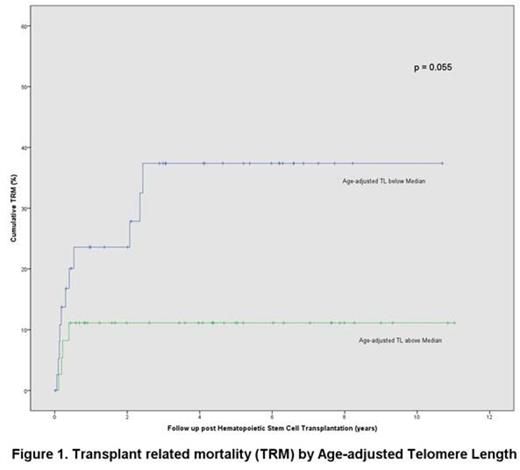Abstract
Introduction
Telomeres are specialized DNA structures found at the end of linear chromosomes. In humans, they contain the repetitive sequence (TTAGGG)nalong with its complementary strand and associated proteins. With each cell division, the telomere shortens due to incomplete replication of the lagging strand, a phenomenon known as the end replication problem. Oxidative damage, as well as the action of nucleases also leads to telomere attrition. Once the telomere reaches a critically short length, cells enter senescence or apoptosis. In the general population, telomere length (TL) varies greatly, and is seen to decline with age. Patients with Dyskeratosis Congenita (DC) have inherently short telomeres, which leads to multiple organ dysfunction. These patients suffer increased organ toxicity when given standard myeloablative conditioning regimens during hematopoietic stem cell transplantation (HSCT). This is most likely due to the reduced ability of their cells to replicate and recover following cytotoxic treatment. It is not known whether patients without DC, who have telomere lengths at the lower end of the normal spectrum also suffer increased rates of toxicity. Thus we undertook a retrospective analysis to determine if there was an association between short TL and increased transplant-related mortality (TRM) following HSCT in children.
Method
Medical records of patients who underwent allogeneic HSCT at the Children's Hospital at Westmead (Sydney, Australia) between 2002 to 2013 were examined and demographic, prior treatment, transplant, toxicity and transplant information was extracted. The primary outcome measured was TRM, while overall survival, relapse and graft versus host disease (GVHD) being secondary outcomes of interest. Stored DNA, extracted from bone marrow, taken within 3 months prior to HSCT was used for telomere length testing, as a surrogate marker for TL in other tissues in the body. Quantitative PCR was carried out to determine relative telomere length, which was converted to an age adjusted TL (AATL) by subtracting the expected relative TL (i.e. 50th percentile for age of the patient) from the measured relative TL, so that patients of all ages could be analyzed together.
Results
Between 2002 and 2013, there were 121 patients who underwent allogeneic HSCT at our institution. Of these, 78 had DNA stored, with appropriate consent and ethics approval to be used in our study. Most children were undergoing HSCT for hematological malignancies (acute lymphoblastic leukemia 52%, acute myeloid leukemia 39%), with 55% having relapse or refractory disease. Matched sibling donors made up 46% of cases. At a median follow up of 3.2 years, 64% of patients remained alive. The single leading cause of death was relapse (48%) with 52% of deaths attributable to transplant-related causes.
The median AATL for the entire cohort was -0.21 (range -0.61-0.28). Telomere length was not associated with relapse or refractory disease. There was no correlation between AATL and specific organ toxicity, relapse or overall survival. When the cohort was divided into 2 groups based on AATL, there was a trend (p=0.055) towards increased TRM in patients who had AATL below the median for the cohort (Figure 1). Multivariate analysis adjusting for age at transplant, CMV status, disease status and HLA matching showed a reduced risk (HR 0.33; p value 0.072) of TRM in patients with AATL above the median for the cohort.
Conclusion
AATL was shorter in patients pre-HSCT compared with age matched controls. There was a trend towards increased TRM in patients with shorter telomere length, however most likely due to small sample size, this did not achieve significance. If extended to a larger cohort of patients, TL may prove to be a significant marker for children at increased risk of TRM prior to HSCT. This could influence the choice to use less myeloablative conditioning in these patients.
Support: NHMRC GNT1056667
No relevant conflicts of interest to declare.
Author notes
Asterisk with author names denotes non-ASH members.


This feature is available to Subscribers Only
Sign In or Create an Account Close Modal